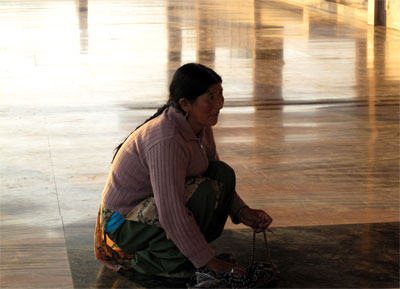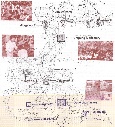|
Dhonden Foundation |
Escape and Exile
In 1959, China violently invaded Tibet, and during the Cultural Revolution of the 1960s, over a million Tibetans lost their lives and nearly 100,000 Tibetans, including His Holiness the Dalai Lama, fled from Tibet. The Chinese destroyed nearly all 6,000 Buddhist monasteries in Tibet, only 13 remained undamaged.
Without
without my land,
mountainous embrace,
pure and white.
without my mother,
generous love,
strength at night.
without my culture,
without my language,Without.
"I was very young, 18 years, when I fled from Tibet to India, so my memories of life in Tibet are mostly youth memories. That was a period when Tibet was independant, a free and self-governing nation, and I think a time when most Tibetans were quite happy. Of course life was also difficult and there was much poverty, but there was complete spiritual freedom. That's very different to the situation as it is now, with all the restrictions, and the very serious punishments that prevent any real religious freedom."
Geshe Sonam Gyaltsen.Monasteries play a key role in the survival and development of Tibetan Buddhism and the Tibetan culture. Most refugees went to poor settlements in India, where they founded over 200 Tibetan monasteries. Just looking at three of the largest monasteries in India, we find over 12,000 monks and nuns.
The Tibetan settlement at Mundgod in S.West India is located some six hours drive from the famous beaches of Goa. This settlement is the largest in India and was founded in 1966. Currently, there are nine camps with two monasteries and a nunnery. In 1999 there were in total about 13,000 residents.
click for an enlargementA Tibetan village in the hot Indian countryside is a special sight. A community of people who are struggling with poor harvests, problems with drinking water, poor medical and educational provisions.
Initially, many Tibetans died from the extreme climatical and cultural differences from the high-altitude Tibet. For example, the traditional food and lack of hygiene caused huge health problems. Since then, programs have developed the settlement conditions. They now have a credit bank for farms, an agricultural institute and a handicraft center. Residents can attend workshops concerning milk production, growing crops, weaving and thanka painting. The Regional Tibetan Women's Organisation assists women with social, cultural, political and health problems of modern society. Also modern technology and communications technology are introduced.However, these developments have not changed the fact that many of the Tibetans are living in serious poverty. The settlement was intended in 1966 for about 5,000 people, but currently there are about 13,000 residents, and the infertile land is unable to produce sufficient crops for this growing population. To protect the poor local Indian population, the Indian government was forced to put all sorts of restrictions on the Tibetan refugees. For example, Tibetans are only allowed to work in a selected number of professions.
|
Office Dhonden
Foundation: p/a Bilderdijkstraat 33, 4819 GA Breda, The Netherlands |
|
KvK
Veluwe & Twente: 08096806 Copyright 2005-2015 © Stichting Dhonden |


